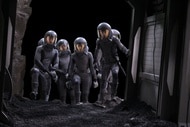Create a free profile to get unlimited access to exclusive videos, sweepstakes, and more!
September’s Full Moon Will Feature a Partial Lunar Eclipse
Look to the skies tonight for a supermoon lunar eclipse.

This month’s full Moon will be the second of four consecutive supermoons. The Moon’s orbit is squashed, not totally circular, so that the Moon gets closer and farther away from the Earth during each lap. Anytime a full Moon happens when the Moon is at or close to perigee (the closest point of its orbit), that’s a supermoon. If that’s not enough to get you outside and looking up, the September full Moon will also feature a partial lunar eclipse.
The celestial show will be visible from most of North America, all of South America, and parts of Africa and Europe. The full Moon officially happens Tuesday night, September 17, at 10:35 p.m. ET, but it will appear Full from Monday night until Thursday morning. It’s unclear how or if lunar eclipses impact werewolves like Wolf Like Me’s Mary (Isla Fisher), but here’s how you can take full advantage of the event.
Everything to Know About September’s Supermoon Lunar Eclipse
Solar eclipses are more famous because they put on an admittedly spectacular show, but lunar eclipses are an incredible opportunity to see the movements of the solar system in action. A solar eclipse happens when the Moon gets between the Earth and the Sun. When we’re lucky, the Sun gets entirely blocked out, revealing its own coronal atmosphere, and the Moon’s shadow falls onto the planet’s surface.
A lunar eclipse happens when the Earth returns the favor, getting between the Moon and the Sun. Usually, when the Moon is full, sunlight flies through the vacuum of space, reflects off the lunar surface, and into our eyes. During a lunar eclipse, sunlight filters through the Earth’s atmosphere first, bending around the blanket and onto the Moon. Most of the light gets scattered away but the orange and red light manages to get through, painting the Moon’s surface in crimson.
The effect is most apparent during a total lunar eclipse, but it happens to a lesser degree even during a partial lunar eclipse, like this one. The Moon will enter the Earth’s penumbra (partial shadow, where only part of the Sun is obscured) at 8:41 p.m. ET. The top edge of the Moon will enter Earth’s umbra (where all of the Sun is blocked out) at 10:13 p.m. and the eclipse will peak about half an hour later, at 10:44 p.m. By then, only about 8% of the Moon’s surface will be inside the umbra. The Moon will completely exit the umbra at 11:16 p.m. and the penumbra at 12:47 a.m., according to NASA.
The entire eclipse will last about four hours, with part of the Moon in the darkest part of Earth’s shadow for about an hour of that time. If you’re planning to go out and look but you don’t want to spend four hours outside, aim for the umbral hour. Whether you miss this partial eclipse or you love it so much you want to see another, the next total lunar eclipse will happen in March 2025. And if you’re looking for more lunar shenanigans after Tuesday night…
Catch Wolf Like Me, streaming now on Peacock.



























